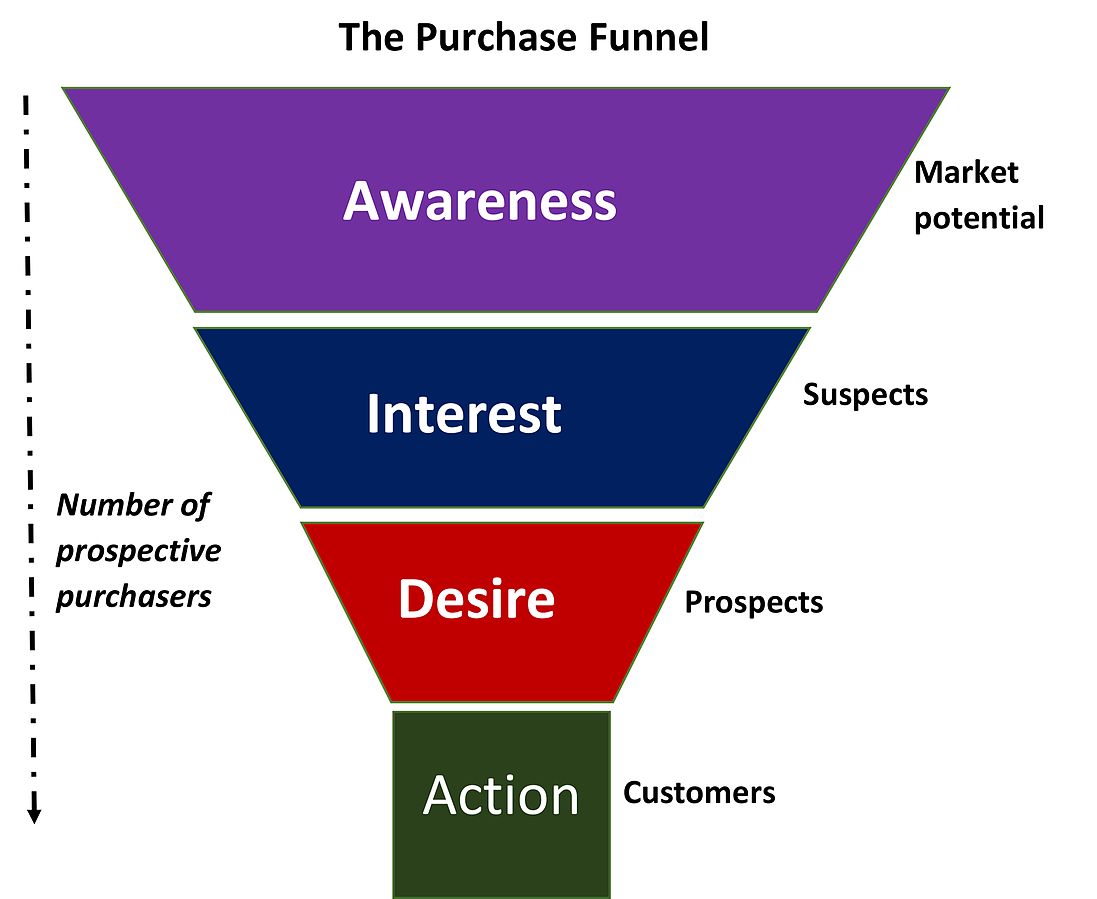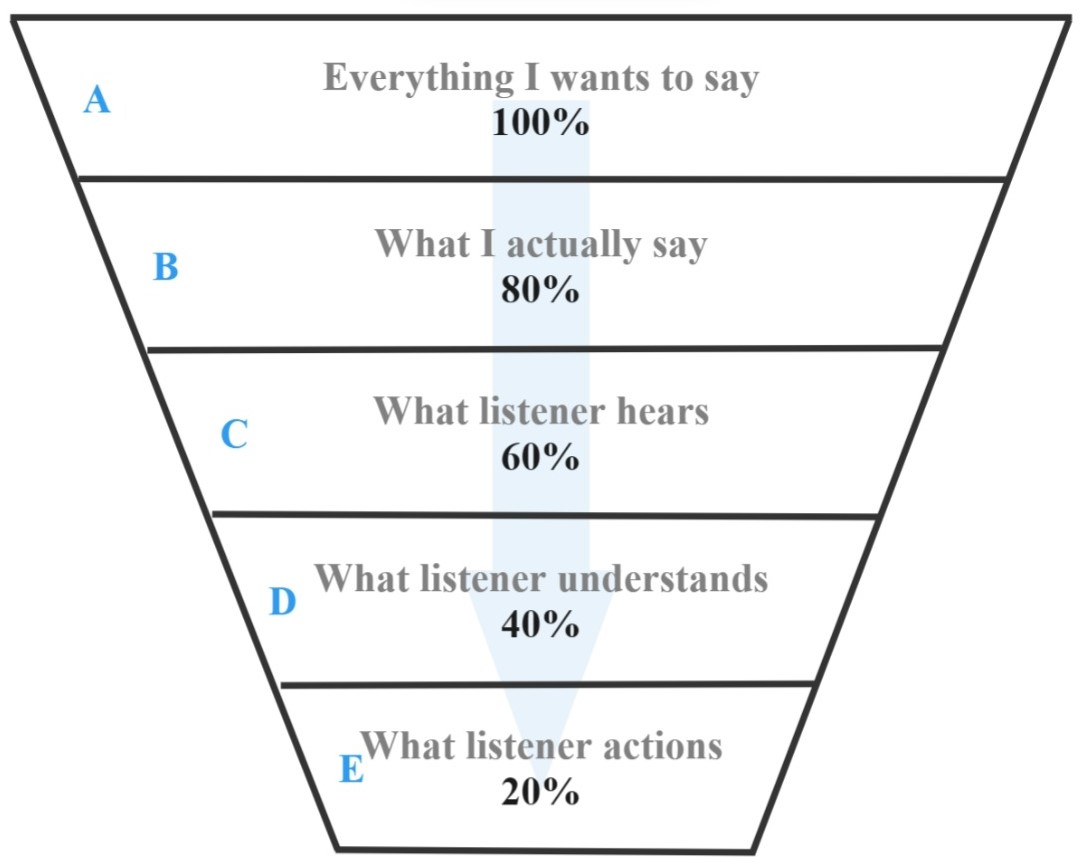Communication Funnel Problems in Project Management
Contents |
Abstract
Projects are made by people, and the project management process is inseparable from communication between people. Everyone has their own identity, professional knowledge, interests, and personality. This makes communication management an important topic in project management. One of the common phenomena is the "communication funnel problems", which vividly illustrate the loss of information in the process of transmission. This article introduces the definition and impact of the communication funnel, analyzes its causes, and proposes solutions for project managers who encounter this problem. The purpose of this article is to improve the efficiency of information transmission in project management.
Big Idea
What are Communication Funnel Problems
The term "communication funnel" originated in the sales industry. In 1898, the American advertising advocate Elias St. Elmo Lewis formulated the slogan "Attract attention, maintain interest, create desire", and later added the fourth term "get action" [1], forming the AIDA hierarchical model. Marketers use AIDA to narrow down targets and identify potential customers step by step. This phenomenon is described as "Purchase Funnel" [2], as shown in Figure 1. With the continuous development of marketing and information dissemination, the concept of "communication funnel" has been widely used in information dissemination activities in different fields and has become a general concept.

Communication funnel problems refer to the phenomena in which information is lost, misunderstood or distorted layer by layer during the transmission process. If what one person wants to say is 100%, then what he actually says is 80% because of expressive skills and other reasons. Due to the perceptual filters, listeners may only hear 60%, understand 40%, and final action 20% [4]. This process looks like a funnel, as shown in Figure 2.
Impacts of Communication Funnel Problems
Projects are made by people, so communication runs through the entire project management process. The communication funnel often leads to inaccurate or incomplete information in project management, which adversely affects the project, such as delaying progress, reducing quality, increasing costs, and ultimately leading to failure to achieve project goals. There are many cases in project management, below is a common example.
A railway reconstruction project needs to replace dilapidated track components within one month to ensure track safety, and the tracks that do not affect traffic can be kept. At the project kick-off meeting, the project manager said to the person in charge of track technology who participated in the project for the first time: "Please try to complete the replacement of old track components within one month." The track technical leader heard the keywords "replace" and "try to within one month". He thought his task is to complete the removal of all old tracks and the installation of new tracks. And the plan is just an approximate time, it doesn't matter if delay of one week. As a result, only 80% of the dilapidated tracks were demolished in one month due to continuous rainy days. The later tasks were delayed because the laying of the new track was not completed, and the unplanned demolition of the old track increased the project cost.
Causes of Communication Funnel Problems
The above case is a typical communication funnel problem. The project manager only described 80% of the task requirements, and the track technical leader only heard 60%, understood 40%, and finally implemented only 20% of the original task. In this information transfer process, due to the lack of a communication plan, the simplification of information, and the difference in the work experience, some information is lost and the communication effect is reduced. This is part of the reason for the communication funnel. The following discusses the four main components of the communication process to analyze the reasons for communication funnel problems.
The process of communication involves four major parts: the communicator, the message, the medium, and the recipient [5], as shown in Figure 3. First, the communicator is the originator of the message. In project management, a project manager typically takes on this role. It is an important role, as the project manager selects the message to be sent among various information channels and content, identifies the appropriate recipient, and translates the message into a language that the recipient can understand. At the same time, the effectiveness and importance of information are also affected by the project manager's actual wording and (in face-to-face communication) body language. Second, the general message includes tasks, thoughts, and feelings. In project management, the main message is the task. The accuracy of task descriptions determines the effectiveness of communication. Then, different mediums are used to transmit information, such as phone calls, text messages, and emails. The kind of medium will affect the emotion and richness of the information. For example, emails are more formal than phone calls. Last, the recipient decides the outcome of the communication, and his or her cultural background, work experience, and ability to interpret information determine the effectiveness of the communication.
Solutions
Solving the communication funnel problem usually requires project managers to adopt effective communication strategies and tools to ensure accurate, timely and comprehensive delivery of information, and to encourage adequate communication and feedback among project members. This helps to establish an effective information transfer and communication mechanism to ensure the smooth progress of the project.
Here are some ways to tackle the communication funnel problem in project management:
- Simplify information transmission: When transmitting information, try to avoid using overly complicated language and concepts, and transmit information in a simple and easy-to-understand manner. The advantage is that it can reduce the difficulty of information transmission and reduce communication errors, but the disadvantage is that some detailed information may be lost.
- Clear communication goals and content: Before communicating, it is necessary to clarify the communication goals and content to ensure that the information can be accurately conveyed to the other party. At the same time, the roles and responsibilities of the receiver need to be clarified so that the information can be properly processed and fed back.
- Establish good communication channels: In project management, good communication channels need to be established so that information can flow smoothly. This can be achieved by establishing a communication matrix, project website, weekly newsletter, etc.
- Use project management tools: Using project management tools can help project managers better track and manage project progress and information flow. For example, tools such as project management software, online collaboration tools, and file-sharing platforms can be used to coordinate and manage projects.
- Establish an effective feedback mechanism: In order to ensure that information can be conveyed correctly and get timely feedback, an effective feedback mechanism needs to be established. This can be achieved by making the frequency and manner of feedback explicit in the project plan. At the same time, the content of the feedback needs to be analyzed and fed back in order to continuously improve communication and information flow in project management.
- Strengthen team building: In project management, strengthening team building can enhance team cohesion and cooperation spirit, and promote information sharing and exchange. This can be done through regular meetings, training, team events, etc.
Discuss: pros and cons of solutions
- Simplify information transfer:
- Advantage: It can reduce the difficulty of information transmission and make the information easier to understand and remember. Misunderstanding and ambiguity in the process of information transmission can be reduced.
- Shortcoming: Some details may be lost, resulting in incomplete information. If the information is oversimplified, it may make the content of the information inaccurate or incomplete.
- Clear communication goals and content:
- Advantage: It can make information transmission more targeted and improve the efficiency of information transmission. It can reduce ambiguity and misunderstanding in the communication process and improve the accuracy of information transmission.
- Shortcoming: Determining your goals and content takes time and effort. If the goals and content are not clear and accurate, it may lead to the failure of information transmission.
- Establish good communication channels & use project management tools:
- Advantage: The accuracy and completeness of the information can be guaranteed, and distortion and omission of information transmission can be avoided. It can improve communication efficiency and reduce misunderstanding and ambiguity in the communication process.
- Shortcoming: It takes more time and effort to perfect the channel and tool content. If both parties are not actively involved, it may lead to the failure of information transmission.
- Feedback mechanism:
- Advantage: Errors in information transmission can be discovered and corrected in time to improve the accuracy of information transmission. It can enhance the interactivity of communication and improve the efficiency and success rate of information transmission.
- Shortcoming: It takes more time and effort to establish and maintain feedback mechanisms. If the feedback mechanism is not timely and accurate enough, it may lead to the failure of information transmission.
- Strengthen team building:
- Advantage: It can promote understanding among team members, better collaboration and cooperation, and improve work efficiency. It can establish a closer relationship and mutual trust, enhance the cohesion of the team, and make members a greater sense of belonging and purpose.
- Shortcoming: It needs to invest a certain amount of time and energy, and it will bring a certain amount of pressure and burden to personal work and life.Certain financial support is required, such as the cost of team building activities, training costs, etc., which may increase the cost of the business.
References
- ↑ Edward. K. S. Jr., 1925. The Psychology of Selling and Advertising. New York: Mcgraw-Hill Book Company. 349. https://babel.hathitrust.org/cgi/pt?id=uc1.$b38792&view=1up&seq=25
- ↑ William W. T., 1924. Bond Salesmanship, 1st ed. New York: Henry Hold and Company. 109. https://babel.hathitrust.org/cgi/pt?id=uc1.$b37470&view=1up&seq=131
- ↑ https://commons.wikimedia.org/wiki/File:The_Purchase_Funnel.jpg
- ↑ Qifeng, 2019. McKinsey Business Communication and Text Writing. China: Tianjin Science Technology Publishing House.
- ↑ Hollingsworth, S., 1987. Communications management. PM Network, 1(3), 45–48. https://www.pmi.org/learning/library/communications-management-9110
- Kerzner, H. (2017). Project management: a systems approach to planning, scheduling, and controlling. John Wiley & Sons.
- Gray, C. F., & Larson, E. W. (2014). Project management: the managerial process. McGraw-Hill Higher Education.
- Project Management Institute. (2017). A guide to the project management body of knowledge (PMBOK guide). Project Management Institute.
- Ellis, S. (2019). Project communication management: a holistic approach. Routledge.
- Klimczak, K. M. (2018). Information management as a source of problems in project communication. LogForum, 14(1), 51-60.
- Gido, J., & Clements, J. P. (2014). Successful project management. Cengage Learning.
- Adler, C. (2007). Project Management and Communication: From Problems to Success. Wiley Publishing
- Kahn, R.E. (1995). Communication in Project Management: A Practical Guide to Communication Techniques. Published by John Wiley & Sons
- Mulally, B. (2010). Best Practices in Project Management. McGraw Hill Press.
- Zhang Zhimin. (2013). Exploration of Communication Management in Project Management. "Modern Enterprise Culture" (6), 159-160
